USPCC: The United States Playing Card Company
The United States Playing Card company started as a printing company called Russell, Morgan & Co in 1867. In 188, they started printing playing cards. The initial brands were: Tigers, Sportsman’s, Army and Navy and Congress. Bicycle cards themselves were not started being manufactured until 1885. The cards took off, and the business thrived. In 1891, the company name was changed to The United States Printing Company. The playing card arm was so successful that it was set up as a separate company in 1894, called - as you now know - The United States Playing Card Company.
Like many other successful companies, their growth was helped by purchasing other, smaller playing card manufacturers. They bought the Standard Playing Card Company, the Perfection Playing Card Company and also the New York Consolidated Card Company (the latter were responsible for making Bee and created the “squeezer” corner pips. They then brought the following brands into the stable: Tally-Ho (Andrew Dougherty), Aristocrat (Russell Playing Card Co.), Fournier (Arrco Playing Card Company and KEM Playing Cards.
The USPCC itself was not immune from acquisition, however. Throughout its history it’s been bought and sold many times. Diamond International bought it in 1969, then Jessup & Lamont in 1982, Frontenac in 1989 and then there was a management buy out in 1994. Finally it was sold to Cartamuni in June 2019.
Brands of USPCC Playing Cards
500
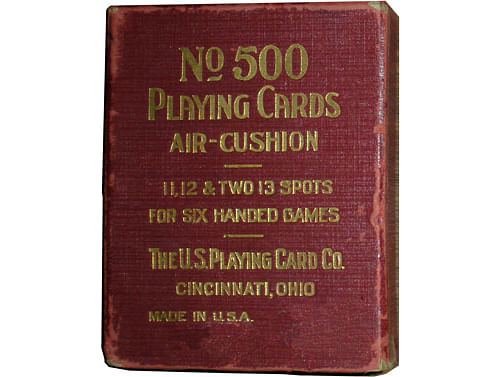 An unusual deck of cards, now mainly exported to Australia. It consists of the normal one through 10 spot playing cards, but additionally has 11, 12 and 13 spot cards. The total number of cards in the deck is 62 if you don’t count the joker. They had four different back designs (Griffin, Full-House, Bid and quite shockingly, Swastika. The latter is now discontinued). Up until the 1970s they came in a very ornate tuck box with gold lettering. During the 1990s, this classy box was phased out and replaced with a plain design that simply reads “500 Playing Card Game".
An unusual deck of cards, now mainly exported to Australia. It consists of the normal one through 10 spot playing cards, but additionally has 11, 12 and 13 spot cards. The total number of cards in the deck is 62 if you don’t count the joker. They had four different back designs (Griffin, Full-House, Bid and quite shockingly, Swastika. The latter is now discontinued). Up until the 1970s they came in a very ornate tuck box with gold lettering. During the 1990s, this classy box was phased out and replaced with a plain design that simply reads “500 Playing Card Game".
Aladdin
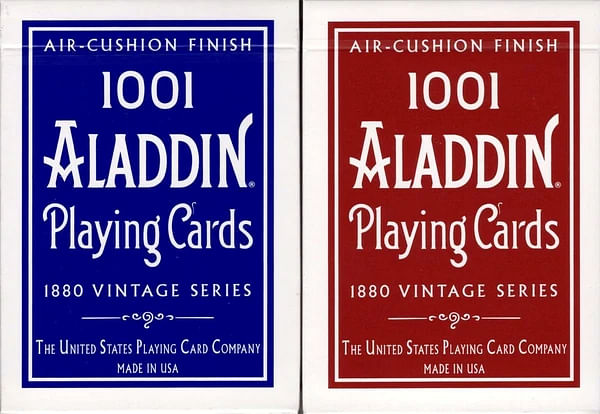 Initially produced in Indianapolis in the 1880s by the National Card Company. There’s been three main variants of the design. The normal “1001” version, one with gilded edges (1002) and even one without indices (1004). Aladdins were manufactured after the acquisition of NCC. They’re still made today by the USPCC mainly for export. They are particularly good at avoiding the normal impact from high humidity areas so are popular in Singapore. They come in two finishes: “smooth finish” and “air-cushion” finish.
Initially produced in Indianapolis in the 1880s by the National Card Company. There’s been three main variants of the design. The normal “1001” version, one with gilded edges (1002) and even one without indices (1004). Aladdins were manufactured after the acquisition of NCC. They’re still made today by the USPCC mainly for export. They are particularly good at avoiding the normal impact from high humidity areas so are popular in Singapore. They come in two finishes: “smooth finish” and “air-cushion” finish.
Aristocrat
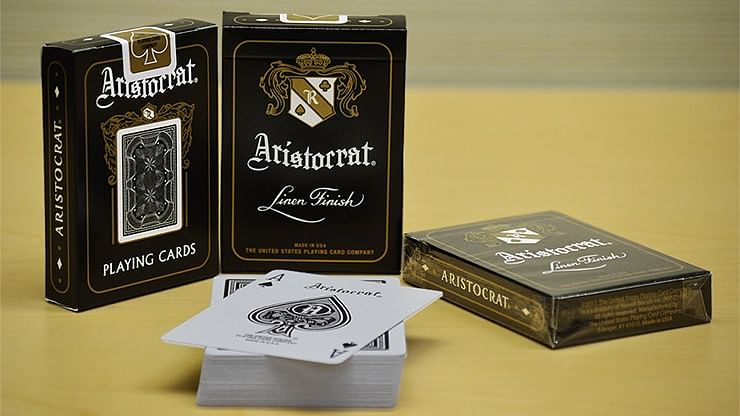 Aristocrats are the creation of the Russell Playing Card company dating back to 1915. (USPCC bought the company in 1929). They are popular thanks to coming on a better quality stock and the highly detailed design. The “bank note” back was very popular thanks to its resemblance to the bills issued by the US government. Particularly popular in casinos, where there was a “Club Special” version of the decks. These were printed without borders and offered casinos the option of having their logo printed on the back. As a consumer brand, they stopped being made in the middle of the 80s, but were still sold to casinos. A retail edition was started up again in 2017 and they still prove popular today.
Aristocrats are the creation of the Russell Playing Card company dating back to 1915. (USPCC bought the company in 1929). They are popular thanks to coming on a better quality stock and the highly detailed design. The “bank note” back was very popular thanks to its resemblance to the bills issued by the US government. Particularly popular in casinos, where there was a “Club Special” version of the decks. These were printed without borders and offered casinos the option of having their logo printed on the back. As a consumer brand, they stopped being made in the middle of the 80s, but were still sold to casinos. A retail edition was started up again in 2017 and they still prove popular today.
Aviator
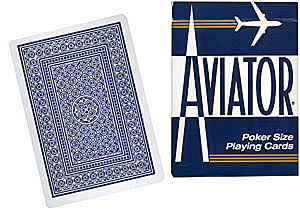 To commemorate the flight across the Atlantic by Charles Lindbergh in the Spirit Of St. Louis, the Aviator brand was created in 1915. More affordable than Bee and Bicycle cards, mainly due to its thinner and untextured stock. Right up until the late 80s, the Ace of Spades and Jokers had absolutely no Aviator branding on them. This is because they were mainly used by the USPCC to produce custom promotional decks for businesses for branding purposes.
To commemorate the flight across the Atlantic by Charles Lindbergh in the Spirit Of St. Louis, the Aviator brand was created in 1915. More affordable than Bee and Bicycle cards, mainly due to its thinner and untextured stock. Right up until the late 80s, the Ace of Spades and Jokers had absolutely no Aviator branding on them. This is because they were mainly used by the USPCC to produce custom promotional decks for businesses for branding purposes.
Bee
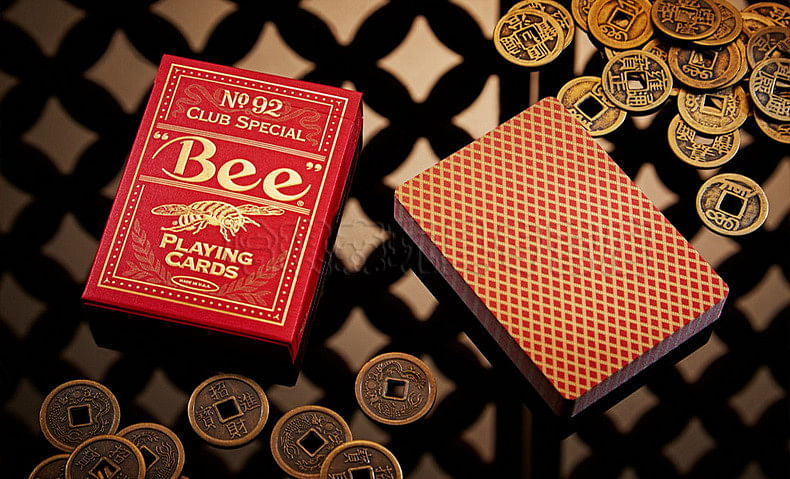 Bees were, and are, primarily a casino brand that is also sold direct to consumers. Initially made by the New York Consolidated Card Company in 1892, which is why they still have the digits “92” on the Ace of Spades. They sport a distinctive borderless, diamond design. An edition known as “No. 35” had a smooth finish and the backs sported a design which is best described as “wiggly worms”. Production of “No. 35” was halted in 2010. They are thought to be popular with magicians who perform gambling dems because the borderless design is thought to make second and bottom dealing more deceptive.
Bees were, and are, primarily a casino brand that is also sold direct to consumers. Initially made by the New York Consolidated Card Company in 1892, which is why they still have the digits “92” on the Ace of Spades. They sport a distinctive borderless, diamond design. An edition known as “No. 35” had a smooth finish and the backs sported a design which is best described as “wiggly worms”. Production of “No. 35” was halted in 2010. They are thought to be popular with magicians who perform gambling dems because the borderless design is thought to make second and bottom dealing more deceptive.
Bicycle
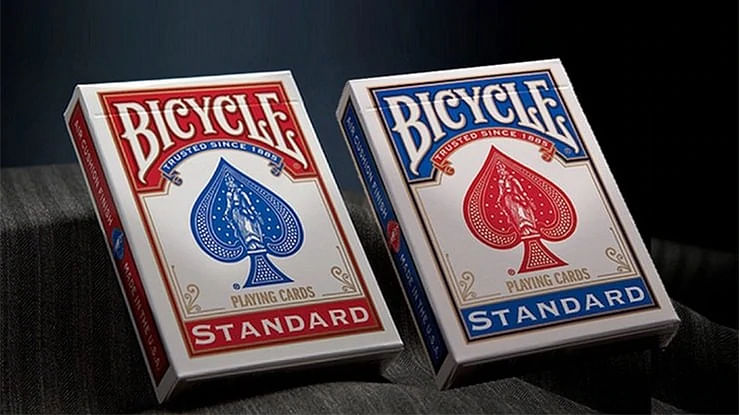 The daddy of them all! 808 Bicycle cards were launched in 1885 and continue to be the USPCC’s flagship brand to this day. Available in two different widths: poker and bridge. They are also available in other set ups for specific card games like pinochle, rummy, euchre and canasta. The most popular back designs re the standard Rider back, along with a Vintage back styled after the original design of the cards back in the day. Now, you can get them in a huge variety of different designs, colorways and a special large index version to help people with low vision - or magicians working a larger room. You can also get jumbo and miniature versions.
The daddy of them all! 808 Bicycle cards were launched in 1885 and continue to be the USPCC’s flagship brand to this day. Available in two different widths: poker and bridge. They are also available in other set ups for specific card games like pinochle, rummy, euchre and canasta. The most popular back designs re the standard Rider back, along with a Vintage back styled after the original design of the cards back in the day. Now, you can get them in a huge variety of different designs, colorways and a special large index version to help people with low vision - or magicians working a larger room. You can also get jumbo and miniature versions.
Congress
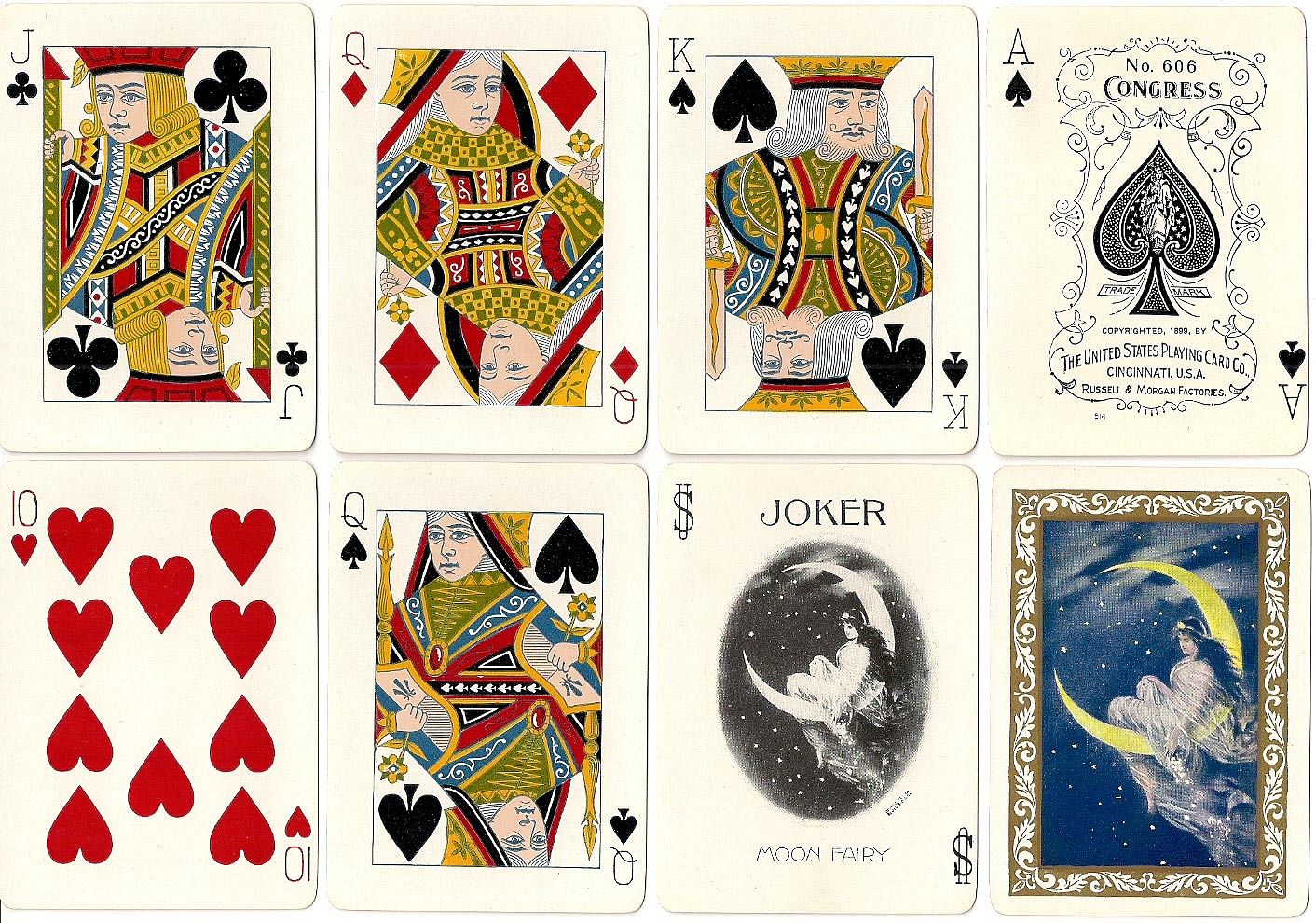 Congress cards cost more than any other brand, and were available in both 404 and 606 stock. The 606 was gilt-edged. Today, this brand is mainly used for bridge and canasta. The tuck boxes are quite unusual. They are a plush velvet box, with a removable drawer insert that houses the cards. They’re normally sold in a two-pack for bridge players. When they were launched, in 1881, they were available in poker, whist and bridge sizes.
Congress cards cost more than any other brand, and were available in both 404 and 606 stock. The 606 was gilt-edged. Today, this brand is mainly used for bridge and canasta. The tuck boxes are quite unusual. They are a plush velvet box, with a removable drawer insert that houses the cards. They’re normally sold in a two-pack for bridge players. When they were launched, in 1881, they were available in poker, whist and bridge sizes.
Fournier
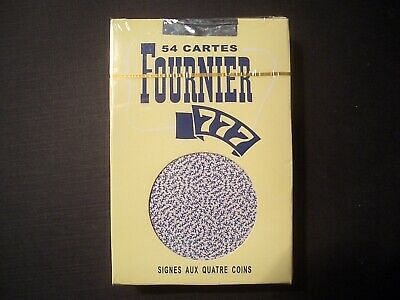 Mainly popular in Europe, Fournier playing cards are also used throughout the world by casinos. Alongside their flagship “No.1” Spanish cards, they also manufacture poker cards, tarot cards and others. USPCC bought them, and now Fournier lean on the Bicycle brand to create decks that use their unique design. They also take advantage of USPCC’s acquisition of KEM, and use the same plastic-coating techniques created by KEM for their No.2100 which is a plastic version of the popular No.1 iteration.
Mainly popular in Europe, Fournier playing cards are also used throughout the world by casinos. Alongside their flagship “No.1” Spanish cards, they also manufacture poker cards, tarot cards and others. USPCC bought them, and now Fournier lean on the Bicycle brand to create decks that use their unique design. They also take advantage of USPCC’s acquisition of KEM, and use the same plastic-coating techniques created by KEM for their No.2100 which is a plastic version of the popular No.1 iteration.
Hoyle
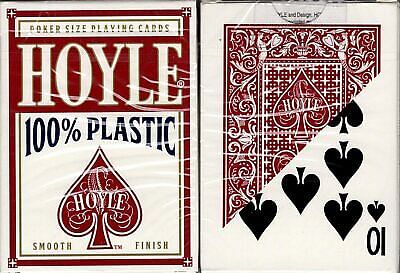 These cards were the main competition Bicycle had for more than seven decades. The shell design on the backs is well known, but the design aspect that sets them apart is the Joker. It is a full color jester with a built in optical illusion. The USPCC bought Hoyle Products in 2001, and rather than kill off the brand, which was their normal MO, they kept several styles in production and introduced a plastic version which proved popular.
These cards were the main competition Bicycle had for more than seven decades. The shell design on the backs is well known, but the design aspect that sets them apart is the Joker. It is a full color jester with a built in optical illusion. The USPCC bought Hoyle Products in 2001, and rather than kill off the brand, which was their normal MO, they kept several styles in production and introduced a plastic version which proved popular.
KEM
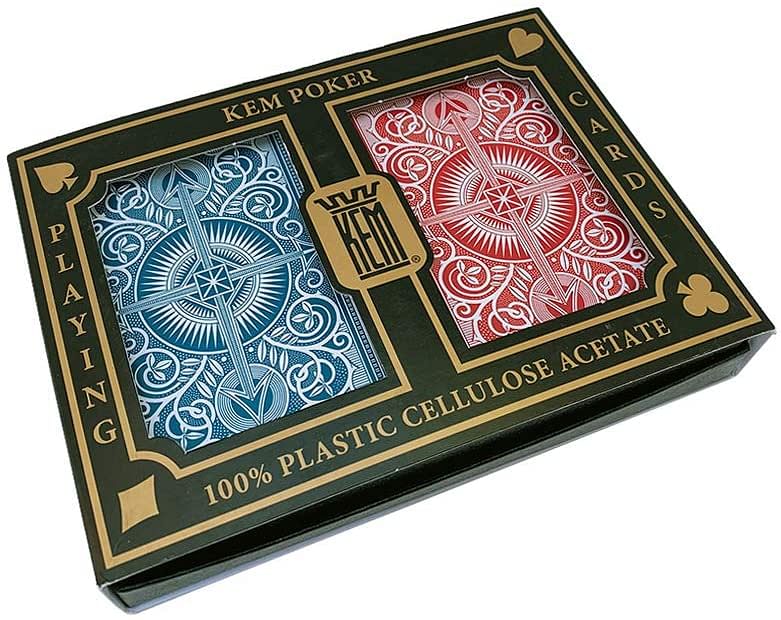
These plastic coated cards have been in production since 1935. They are manufactured from cellulose acetate and are 100% waterproof. USPCC acquired them in 2004 and production was halted. Two years later it was started up again, and carries on today. Available direct to the consumer, they’re now available in a huge array of colorways, and are the official cards of the World Series of Poker.
Maverick
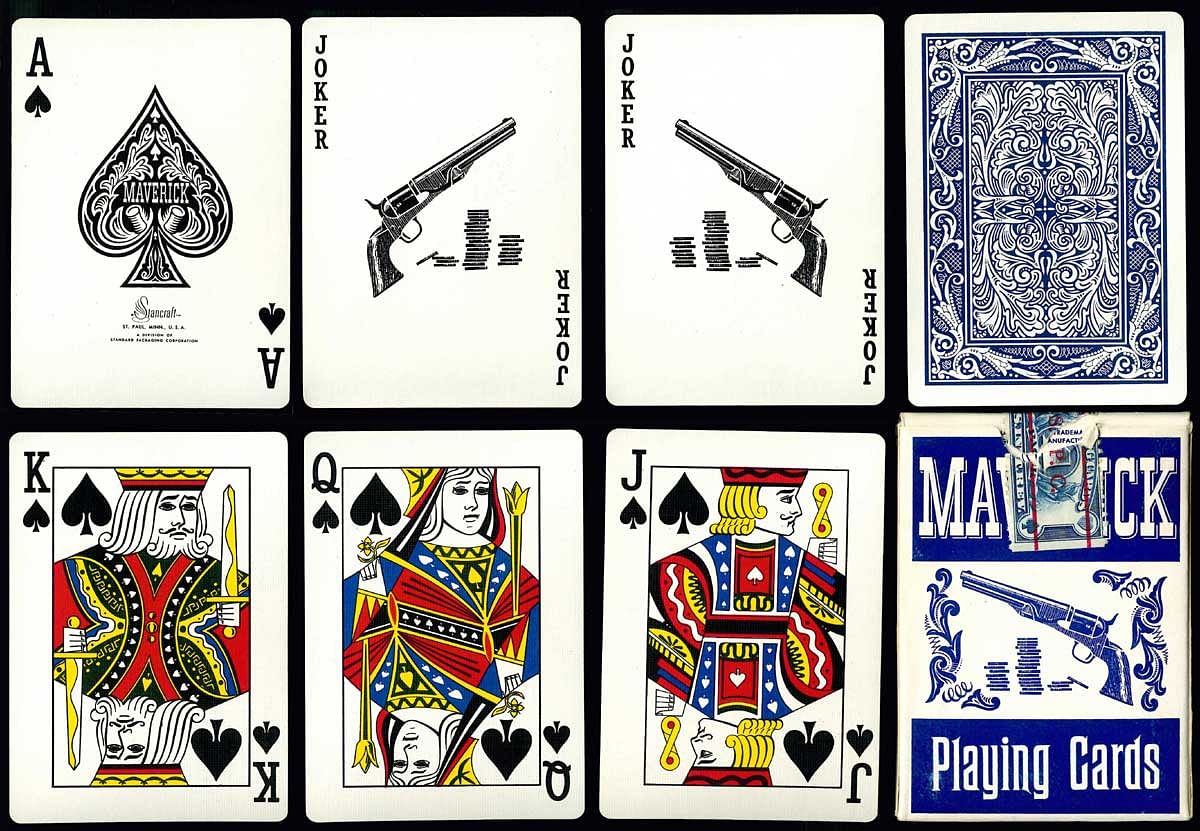 These were the low-cost cards made by Hoyle, which the USPCC bought in 2001. Initially launched in 1959 to coincide with the hugely successful TV show of the same name. Mavericks are one of the few brands where the printing is outsourced to third parties and not performed by the USPCC.
These were the low-cost cards made by Hoyle, which the USPCC bought in 2001. Initially launched in 1959 to coincide with the hugely successful TV show of the same name. Mavericks are one of the few brands where the printing is outsourced to third parties and not performed by the USPCC.
Rambler
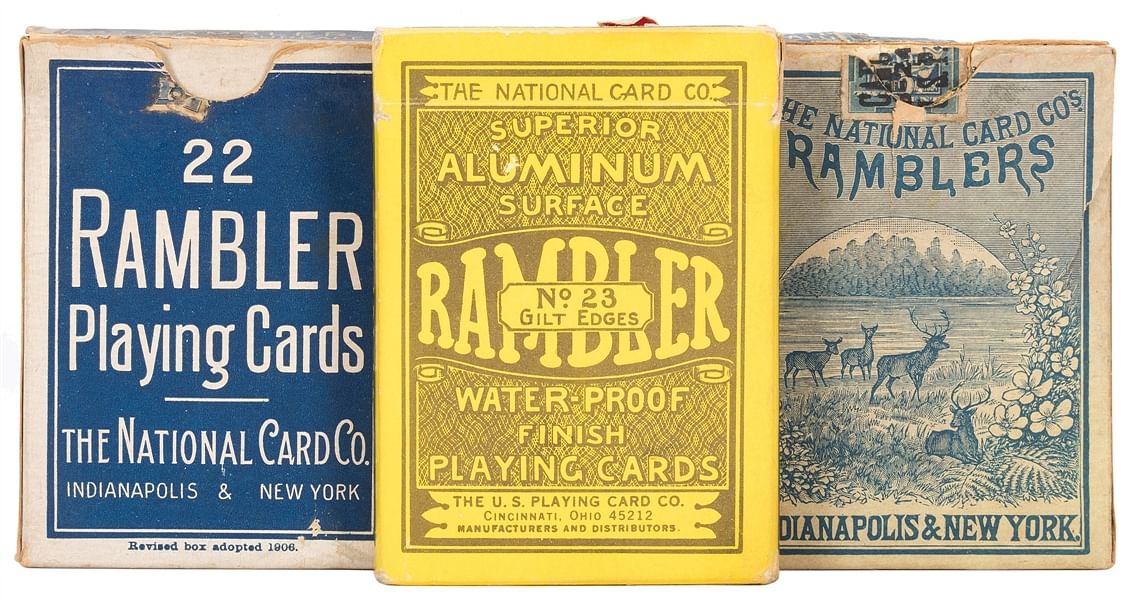 One of the earliest gilt-edged cards produced, Ramblers were initially made by the National Card Company and sported a aluminum oxide finish which made them waterproof. This process made them very suitable for high humidity environments, and like Aladdins, they are mainly exported to Asia.
One of the earliest gilt-edged cards produced, Ramblers were initially made by the National Card Company and sported a aluminum oxide finish which made them waterproof. This process made them very suitable for high humidity environments, and like Aladdins, they are mainly exported to Asia.
Streamline
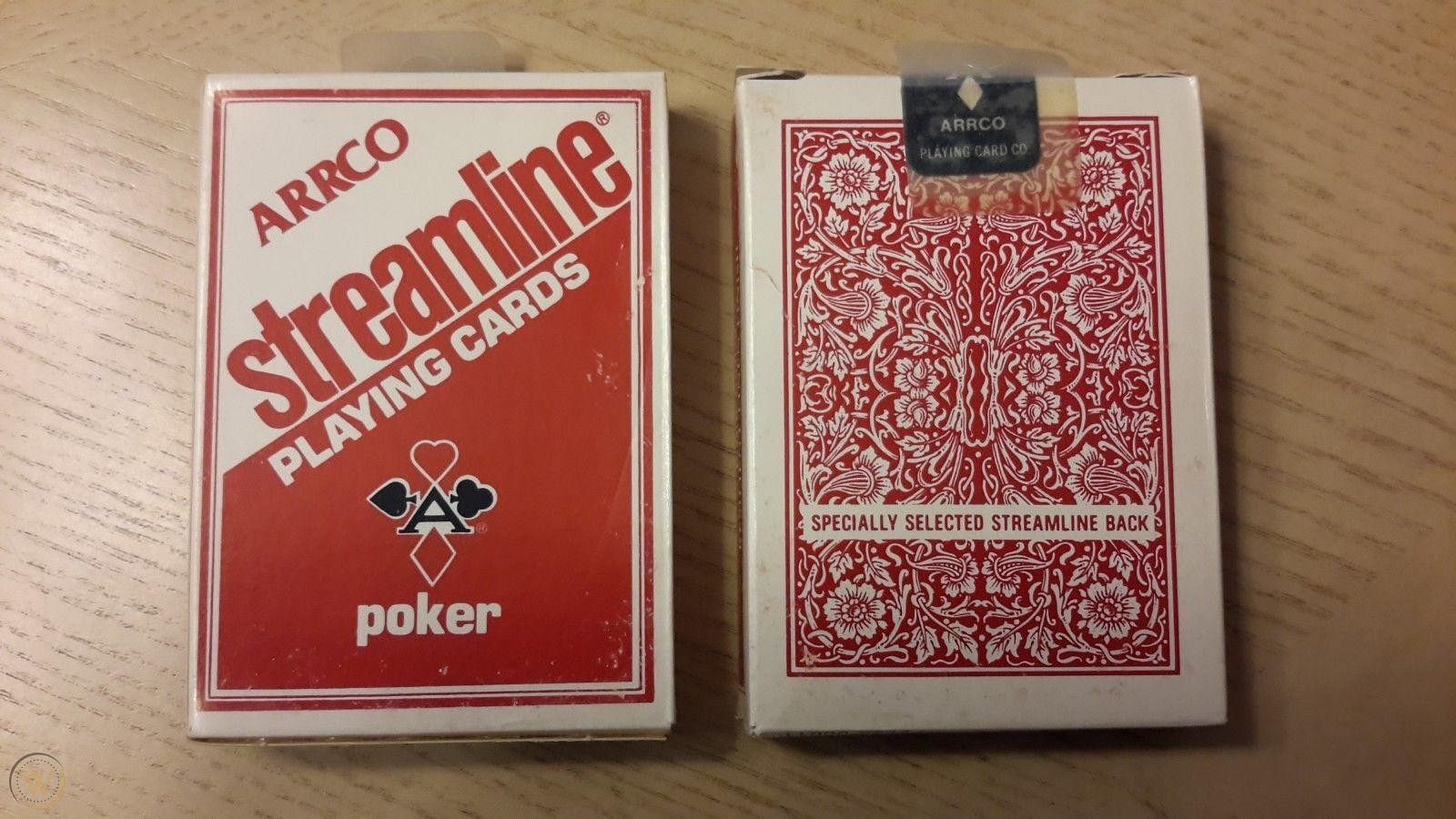 Arrco Playing Card Company initially prodiuced Streamlines, and this budget brand came to the USPCC back in 1987 via another acquisition. It’s a cheap brand and sits with Mavericks. It has a mono back design, with borders and a plastic-coated finish. Again, the production of these cards is not undertaken by the USPCC but is outsourced.
Arrco Playing Card Company initially prodiuced Streamlines, and this budget brand came to the USPCC back in 1987 via another acquisition. It’s a cheap brand and sits with Mavericks. It has a mono back design, with borders and a plastic-coated finish. Again, the production of these cards is not undertaken by the USPCC but is outsourced.
Squeezers
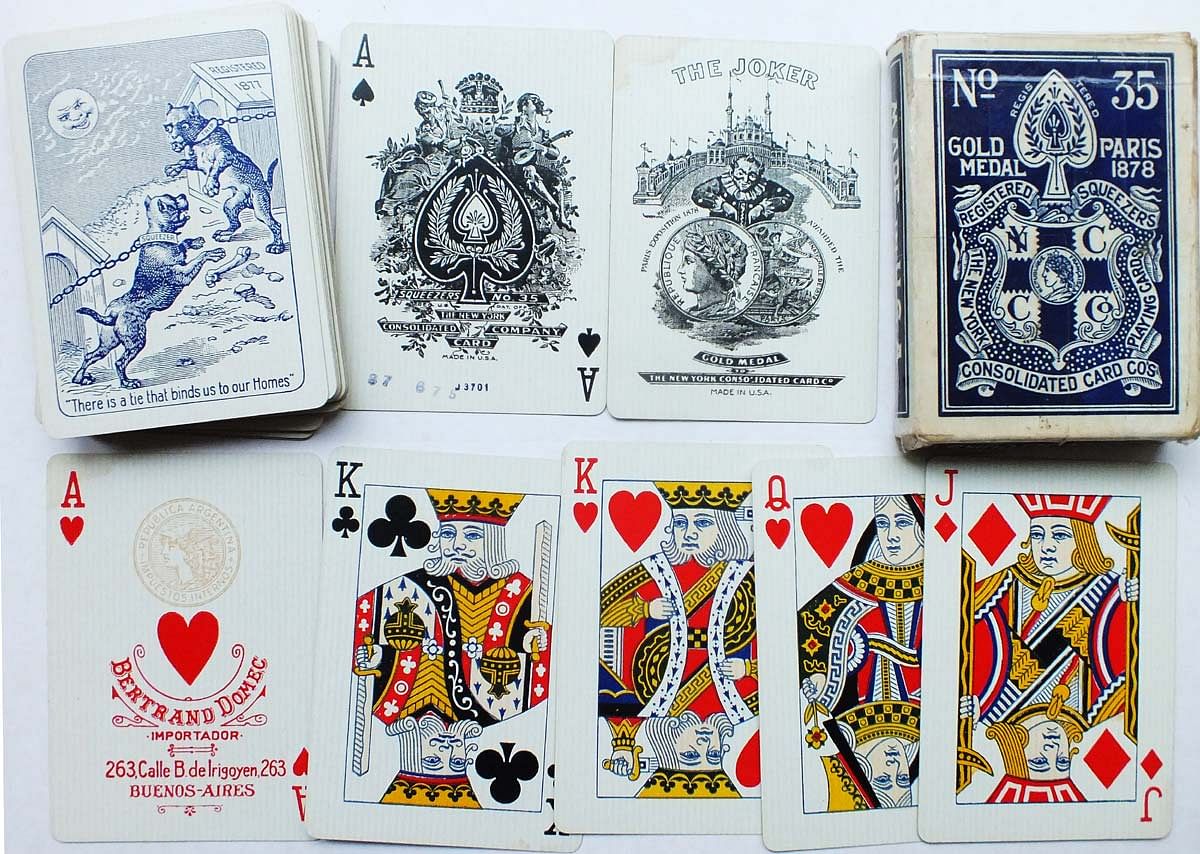 Another brand initially designed by the New York Consolidated Card Company. Along with Andrew Dougherty and the Standard Playing Card Company, the three companies merged to create a division of the USPCC known as Consolidated-Dougherty, Squeezers have the Cambric finish made famous by Bee and they used to have a large variety of backs. Today, only the Bulldog and Angel Back are still being produced. They are only printed occasionally and are not in continual production.
Another brand initially designed by the New York Consolidated Card Company. Along with Andrew Dougherty and the Standard Playing Card Company, the three companies merged to create a division of the USPCC known as Consolidated-Dougherty, Squeezers have the Cambric finish made famous by Bee and they used to have a large variety of backs. Today, only the Bulldog and Angel Back are still being produced. They are only printed occasionally and are not in continual production.
Tally-Ho
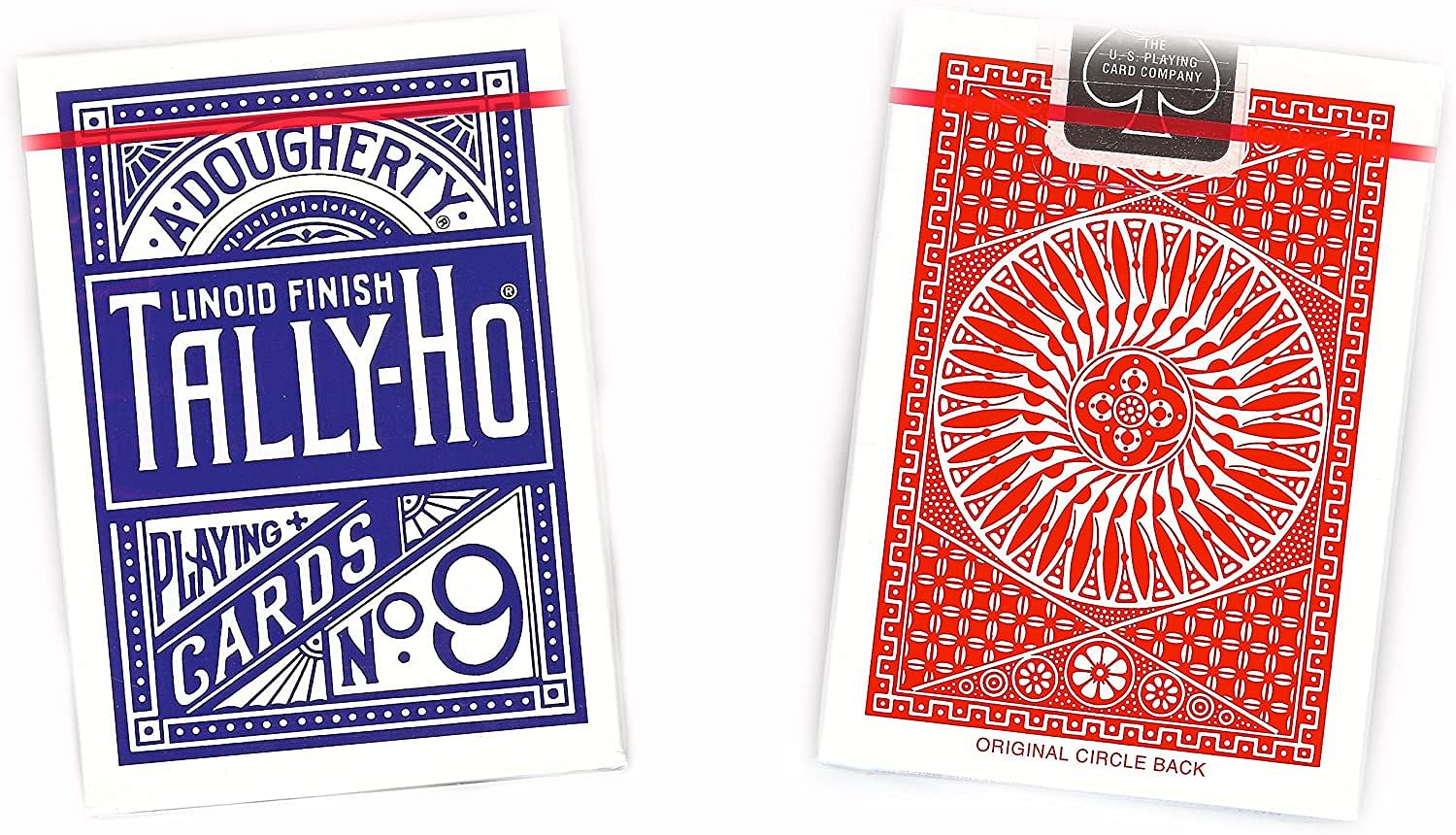 Andrew Dougherty was one of the world’s earliest manufacturers of playing cards and they introduced Tally-Hos back in 1885. USPCC bought them in 1907. The Fan and Circle backs are still made today, and they’re popular with cardists and flourishers thanks to their unusual linoid finish.
Andrew Dougherty was one of the world’s earliest manufacturers of playing cards and they introduced Tally-Hos back in 1885. USPCC bought them in 1907. The Fan and Circle backs are still made today, and they’re popular with cardists and flourishers thanks to their unusual linoid finish.
Browse all our playing cards
